Related Research Articles
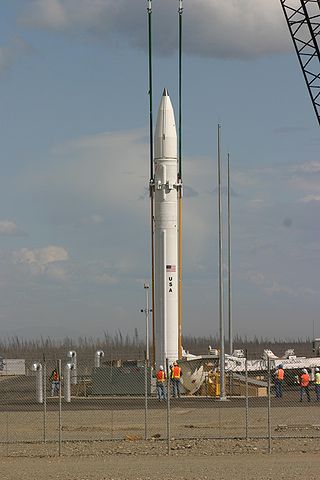
An anti-ballistic missile (ABM) is a surface-to-air missile designed to counter ballistic missiles. Ballistic missiles are used to deliver nuclear, chemical, biological, or conventional warheads in a ballistic flight trajectory. The term "anti-ballistic missile" is a generic term for a system designed to intercept and destroy any type of ballistic threat; however, it is commonly used for systems specifically designed to counter intercontinental ballistic missiles (ICBMs).
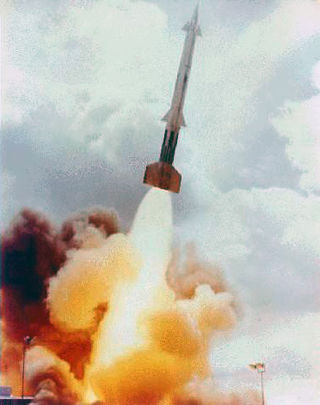
The Anti-Ballistic Missile Treaty, also known as the ABM Treaty or ABMT, was an arms control treaty between the United States and the Soviet Union on the limitation of the anti-ballistic missile (ABM) systems used in defending areas against ballistic missile-delivered nuclear weapons. It was intended to reduce pressures to build more nuclear weapons to maintain deterrence. Under the terms of the treaty, each party was limited to two ABM complexes, each of which was to be limited to 100 anti-ballistic missiles.

An intercontinental ballistic missile (ICBM) is a ballistic missile with a range greater than 5,500 kilometres (3,400 mi), primarily designed for nuclear weapons delivery. Conventional, chemical, and biological weapons can also be delivered with varying effectiveness, but have never been deployed on ICBMs. Most modern designs support multiple independently targetable reentry vehicle (MIRVs), allowing a single missile to carry several warheads, each of which can strike a different target. The United States, Russia, China, France, India, the United Kingdom, Israel, and North Korea are the only countries known to have operational ICBMs. Pakistan is the only nuclear-armed state that does not possess ICBMs.
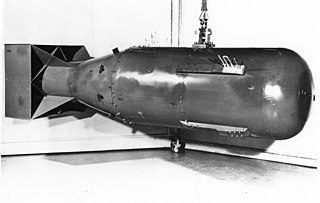
In nuclear strategy, a first strike or preemptive strike is a preemptive surprise attack employing overwhelming force. First strike capability is a country's ability to defeat another nuclear power by destroying its arsenal to the point where the attacking country can survive the weakened retaliation while the opposing side is left unable to continue war. The preferred methodology is to attack the opponent's strategic nuclear weapon facilities, command and control sites, and storage depots first. The strategy is called counterforce.

The LGM-30 Minuteman is an American land-based intercontinental ballistic missile (ICBM) in service with the Air Force Global Strike Command. As of 2024, the LGM-30G is the only land-based ICBM in service in the United States and represents the land leg of the U.S. nuclear triad, along with the Trident II submarine-launched ballistic missile (SLBM) and nuclear weapons carried by long-range strategic bombers.
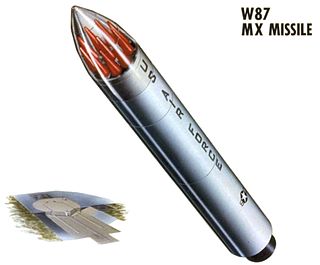
A multiple independently targetable reentry vehicle (MIRV) is an exoatmospheric ballistic missile payload containing several warheads, each capable of being aimed to hit a different target. The concept is almost invariably associated with intercontinental ballistic missiles carrying thermonuclear warheads, even if not strictly being limited to them. An intermediate case is the multiple reentry vehicle (MRV) missile which carries several warheads which are dispersed but not individually aimed. All nuclear-weapon states except Pakistan and North Korea are currently confirmed to have deployed MIRV missile systems.

Chevaline was a system to improve the penetrability of the warheads used by the British Polaris nuclear weapons system. Devised as an answer to the improved Soviet anti-ballistic missile defences around Moscow, the system increased the probability that at least one warhead would penetrate Moscow's anti-ballistic missile (ABM) defences, something which the Royal Navy's earlier UGM-27 Polaris re-entry vehicles (RVs) were thought to be unlikely to do.

The LGM-118 Peacekeeper, originally known as the MX for "Missile, Experimental", was a MIRV-capable intercontinental ballistic missile (ICBM) produced and deployed by the United States from 1986 to 2005. The missile could carry up to eleven Mark 21 reentry vehicles, each armed with a 300-kiloton W87 warhead. Initial plans called for building and deploying 100 MX ICBMs, but budgetary concerns limited the final procurement; only 50 entered service. Disarmament treaties signed after the Peacekeeper's development led to its withdrawal from service in 2005.

START II was a bilateral treaty between the United States and Russia on the Reduction and Limitation of Strategic Offensive Arms. It was signed by US President George H. W. Bush and Russian President Boris Yeltsin on 3 January 1993, banning the use of multiple independently targetable re-entry vehicles (MIRVs) on intercontinental ballistic missiles (ICBMs). Hence, it is often cited as the De-MIRV-ing Agreement.
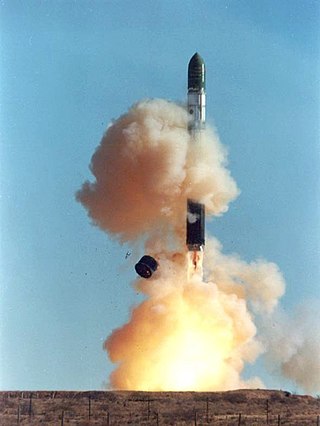
The R-36 is a family of intercontinental ballistic missiles (ICBMs) and space launch vehicles (Tsyklon) designed by the Soviet Union during the Cold War. The original R-36 was deployed under the GRAU index 8K67 and was given the NATO reporting name SS-9 Scarp. It was able to carry three warheads and was the first Soviet MRV missile. The later version, the R-36M, also known as RS20, was produced under the GRAU designations 15A14 and 15A18 and was given the NATO reporting name SS-18 Satan. This missile was viewed by certain United States analysts as giving the Soviet Union first strike advantage over the U.S., particularly because of its rapid silo-reload ability, very heavy throw weight and extremely large number of re-entry vehicles. Some versions of the R-36M were deployed with 10 warheads and up to 40 penetration aids and the missile's high throw-weight made it theoretically capable of carrying more warheads or penetration aids. Contemporary U.S. missiles, such as the Minuteman III, carried up to three warheads at most.

Missile defense is a system, weapon, or technology involved in the detection, tracking, interception, and also the destruction of attacking missiles. Conceived as a defense against nuclear-armed intercontinental ballistic missiles (ICBMs), its application has broadened to include shorter-ranged non-nuclear tactical and theater missiles.

The Safeguard Program was a U.S. Army anti-ballistic missile (ABM) system designed to protect the U.S. Air Force's Minuteman ICBM silos from attack, thus preserving the US's nuclear deterrent fleet. It was intended primarily to protect against the very small Chinese ICBM fleet, limited Soviet attacks and various other limited-launch scenarios. A full-scale attack by the Soviets would easily overwhelm it. It was designed to allow gradual upgrades to provide similar lightweight coverage over the entire United States over time.

Nuclear weapons delivery is the technology and systems used to place a nuclear weapon at the position of detonation, on or near its target. Several methods have been developed to carry out this task.
Anti-ballistic missile defense countermeasures are tactical or strategic actions taken by an attacker to overwhelm, destroy, or evade anti-ballistic missile defenses.

A nuclear triad is a three-pronged military force structure of land-based intercontinental ballistic missiles (ICBMs), submarine-launched ballistic missiles (SLBMs), and strategic bombers with nuclear bombs and missiles. Countries build nuclear triads to eliminate an enemy's ability to destroy a nation's nuclear forces in a first-strike attack, which preserves their own ability to launch a second strike and therefore increases their nuclear deterrence.
A penetration aid is a device or tactic used to increase an aircraft's capability of reaching its target without detection, and in particular intercontinental ballistic missile (ICBM) warhead's chances of penetrating a target's defenses.
In nuclear strategy, a counterforce target is one that has a military value, such as a launch silo for intercontinental ballistic missiles, an airbase at which nuclear-armed bombers are stationed, a homeport for ballistic missile submarines, or a command and control installation.

Nike Zeus was an anti-ballistic missile (ABM) system developed by the United States Army during the late 1950s and early 1960s that was designed to destroy incoming Soviet intercontinental ballistic missile warheads before they could hit their targets. It was designed by Bell Labs' Nike team, and was initially based on the earlier Nike Hercules anti-aircraft missile. The original, Zeus A, was designed to intercept warheads in the upper atmosphere, mounting a 25 kiloton W31 nuclear warhead. During development, the concept changed to protect a much larger area and intercept the warheads at higher altitudes. This required the missile to be greatly enlarged into the totally new design, Zeus B, given the tri-service identifier XLIM-49, mounting a 400 kiloton W50 warhead. In several successful tests, the B model proved itself able to intercept warheads, and even satellites.

Sentry, known for most of its lifetime as LoADS for Low Altitude Defense System, was a short-range anti-ballistic missile (ABM) design made by the US Army during the 1970s. It was proposed as a defensive weapon that would be used in concert with the MX missile, a US Air Force ICBM that was under development.
Prim–Read theory, or Prim–Read defense, was an important development in game theory that led to radical changes in the United States' views on the value of anti-ballistic missile (ABM) systems. The theory assigns a certain cost to deploying defensive missiles and suggests a way to maximize their value in terms of the amount of damage they could reduce. By comparing the cost of various deployments, one can determine the relative amount of money needed to provide a defense against a certain number of ICBMs.
References
- Stashwick, Steven (13 July 2016). "US Navy's Futuristic New Weapons Could be Key to Limiting a Clash with China". The Diplomat.
- Field, G; Spergel, D (21 March 1986). "Cost of space-based laser ballistic missile defense". Science. 231 (4744): 1387–1393. Bibcode:1986Sci...231.1387F. doi:10.1126/science.231.4744.1387. PMID 17748077. S2CID 28309749.